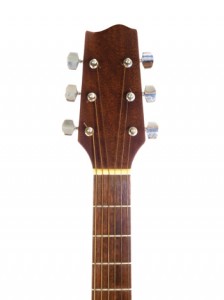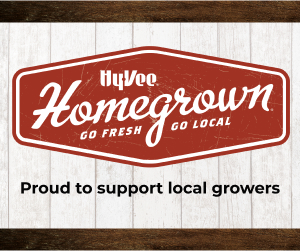
Written by Kyle Oppenhuizen
Ten years ago, after seeing a number of upscale lifestyle magazines in her travels, Business Publications chair Connie Wimer wondered why Des Moines couldn’t have a similar publication. The result of her reverie? The magazine you’re reading.
Look around the metro area and you’ll see evidence of countless other ways community activists and leaders have answered the question “Why not Des Moines?” with concrete action. The idea for last year’s inaugural Wonder of Words Festival, for instance, was launched after Glenn Lyons, president and CEO of the Downtown Community Alliance, experienced a similar event in Tucson, Ariz. Earlier in the decade, John and Mary Pappajohn were driving down Locust Street and wondered why the city couldn’t have a world-class sculpture park, like, say, the Minneapolis Sculpture Garden. “We looked over at each other and the light went on,” John Pappajohn told dsm in 2008. We all know what that spark ignited: the $40 million John and Mary Pappajohn Sculpture Park.
The “why not” list from the past decade also could include Winefest Des Moines, dsm’s Top Chef competition and Restaurant Week, the 80/35 music festival, the revitalization of the Greater Des Moines Botanical Garden, the Principal Riverwalk, the free outdoor Shakespeare festival, last year’s blockbuster Buddhist relics exhibit, and streetscaping projects along Fleur Drive and Ingersoll Avenue, among others.
“In some sense, we have really captured the imagination of the best of a lot of cities,” observes J. Barry Griswell, CEO of the Community Foundation of Greater Des Moines.
What else can the metro area “capture” from other cities? When we posed the question to people around town, the creative ideas flowed. Find what they are on the following pages. On page 74, read about MD Isley’s vision of Des Moines as the nation’s next arts and cultural capital, and on page 76, check out ideas from dsm and Business Record staffers.
 Matt Homonoff
Matt Homonoff
General Manager, Des Moines Menace
Idea: an international soccer event
Model: Multiple cities, including Kansas City
Description:
“I would love to see a high-level international soccer event here,” says Homonoff. Kansas City, Chicago and Columbus, Ohio, have all recently hosted events involving teams from Latin America playing against local teams, he says. “With the growing Mexican-American demographic and the clear love for the beautiful game throughout the population in general, a mid- to large-scale event involving teams from the United States and Latin America and Mexico would be well-received here,” he says.
Bethany Wilcoxon
Senior Transportation Planner, Des Moines Area Metropolitan Planning Organization
Idea: “Edible” bus stops
Model: London
Description: “Edible” bus stops are basically concrete areas along a bus route revamped into community gardens. “We see a growing desire for public transportation,” says Wilcoxon, who is one of the leaders heading up the Metropolitan Planning Organization’s “The Tomorrow Plan” process. “We see these empty, bleak lots around the region just waiting to be improved. At the same time, we see the need for more healthy food coupled with a growing urban gardening movement. Edible bus stops address all of these issues at once.” Des Moines Area Regional Transit Authority’s new Route 60, a loop between Ingersoll Avenue and University Avenue that goes through downtown, could provide one good place to implement these gardens, she says.
Mashal Husain
Director of Development and Finance, World Food Prize Foundation
Idea: An international school
Model: Multiple cities
Description: As a mother, Husain says she would like her son to have the opportunity to experience the “international school philosophy, where learning is integrated from a global point of view, where history is taught from the perspective of different nations and not just one, where students are encouraged to embrace global understanding and become citizens of the world.” Husain, who was raised in Pakistan, Tanzania, the Philippines and Thailand, credits the international schools in those countries for providing her with that type of education. “After all, it will take the world community to solve the issues of tomorrow,” she says.
Michael Andresen
Architect, RDG Planning & Design
Idea: An “eco-district”
Model: Portland, Ore.; Vancouver, Wash.
Description: Develop an eco-district, defined as a neighborhood or area that incorporates sustainable principles, Andresen suggests. It could come in many forms; for example, the district could include existing space that would be adapted for new uses, such as the World Food Prize Hall of Laureates and the John and Mary Pappajohn Sculpture Park, as well as mixed-use buildings, similar to the Davis Brown Tower, which add “economic vitality and diversity to urban areas,” he says. Andresen also points to the Des Moines Area Metropolitan Planning Organization’s “The Tomorrow Plan,” which suggests “greenways” such as storm water management, purposeful open space and smart energy grid solutions.
Christian Renaud
Principal, StartupCity Des Moines
Idea: More support for student entrepre-neurs
Model: Palo Alto, Calif., and Stanford University
Description: “Startup company support”—or big companies buying from local startups—in Des Moines is “just now taking root,” Renaud says. But it’s not present at all for student startups. “Given how hard it is to gain adoption and traction, the student startup mortality rate is very high, and therefore the quantity we see is dropping each year,” says Renaud, who spent time working and living in both Northern and Southern California before returning home to
Des Moines. “If we are serious about retaining or growing the number of young people in Iowa, we need to lean forward as a community to embrace these budding entrepreneurs, or risk losing them to communities that do actively cultivate these future business leaders.”
 Cat Rocketship
Cat Rocketship
Des Moines artist and blogger
Idea: Car-sharing program
Model: Multiple cities
Description: “I am most jealous of other cities when I read about car-sharing membership programs like Zipcar,” says Rocketship. who, with her husband, Scott Kubie, runs whatifdesmoines.com. “It would be great to be able to bus downtown and check out a car when I need one, and businesses like this can help reduce the number of cars per capita in the city and also enable people to drive less and walk, bike and bus more.” Other ideas: A community push to finance and install enough solar panels to make downtown carbon neutral, neighborhood tool shares and more community-driven movements in general. “By combining our needs and our resources, our push for a better city goes farther,” she says.
Richard Swearinger
Freelance Food Writer, former Senior Food Editor for Better Homes and Gardens magazine
Idea: Raw food restaurant
Model: Los Angeles
Description: Swearinger cites Cafe Gratitude in Los Angeles as an example of what a raw food restaurant could be like in Des Moines. “With all the wonderful ingredients flowing into this town, it’s high time we take advantage of them,” he says. At Cafe Gratitude, the names of the dishes are all statements such as “I Am Fabulous” or “I Am Irresistible.” And when the servers deliver a plate, they turn around the phrase to say “You are fabulous.” “It would be a delight to hear phrases like that coming out of the mouths of our local servers,” Swearinger says.
Jill Haverkamp
Co-Founder, On Pitch LLC
Idea: Music industry conference
Model: Austin, Texas
Description: Haverkamp and On Pitch co-founder Hillary Brown hosted a panel at Austin’s South by Southwest music festival and conference in 2011 titled “Landing a Music Career in Flyover Country.” “We immediately thought, ‘Why can’t Des Moines have a conference like South by Southwest?’ ” Haverkamp says. The conference would feature a range of panels and seminars for musicians, venue owners, recording engineers and producers. “Notable industry professionals from across the country would come to Des Moines to share their knowledge and get a taste for our city along the way,” Haverkamp says.
 Kent Newman
Kent Newman
Executive Director of the Center on Sustainable Communities
Idea: Green-houses
Model: Multiple cities
Description: Greenhouses, created through public-private partnerships, would be an affordable and sustainable way to grow food that could be produced and consumed by local families, schools, hospitals and other institutions, Newman says. The greenhouses could provide education for students as well as training for adults, he suggests. Another local food system option, Newman adds, would be to provide access to land where different groups, such as recent immigrants, could produce food for farmers markets and restaurants. Training in marketing and distribution also would be provided.
Gunnar Olson
Public Affairs Manager, Des Moines Area Regional Transit Authority (DART)
Idea:
Bus rapid transit
Model: Multiple cities, including Kansas City
Description: Many young professionals would like a light rail system, similar to what exists in larger cities such as Chicago or Washington, D.C., but that might not be as feasible in Des Moines. The next best thing: a rail-like bus system, Olson says. That’s what bus rapid transit (BRT) could bring to Des Moines. A BRT line would have more frequent service, “stations” instead of stops, more space between pickup points than normal routes and even potentially designated street lanes where bus drivers could have the ability to change red lights to green, he explains. DART hopes to eventually make its new Route 60 loop between Ingersoll and University avenues into a BRT line, but first must obtain state funding, Olson adds.
J. Barry Griswell
CEO of the Community Foundation of Greater Des Moines
Idea: City sustain-ability program
Model: Dubuque
Description: Dubuque’s “Smarter Sustainable Dubuque” program is a public-private partnership between the city and IBM Research. Initiated in 2009, the program aims to develop “smarter” technologies and implementation strategies to create an international model of sustainability for communities of 200,000 or fewer people. For example, the partnership created a “Smarter Water Portal,” an interactive website that allows up to 4,000 households and small businesses to more closely monitor their water usage. “Wouldn’t it be really neat if Des Moines was recognized as an ecological, or a conservation, sustainability center?” Griswell asks. Capital Crossroads has identified sustainability as a priority, and Griswell hopes similar initiatives can emerge from that plan.
Janis Ruan
Community volunteer and a board member of the Greater Des Moines Botanical Garden
Idea: A street-scape on Walnut Street
Model: Chicago
Description: Ruan points to Chicago’s North Michigan Avenue, often referred to as the “Miracle Mile,” as evidence of how streetscaping can help transform an area. After Crate and Barrel owner Gordan Segal placed one planter in front of the store, “the idea became contagious,” she says, adding she believes something similar could happen on Walnut Street. “Streetscape beautification brings momentum and renewed enthusiasm to a city,” says Ruan, who led the streetscape beautification projects along Fleur Drive and Ingersoll Avenue and the development of the gardens at the World Food Prize Hall of Laureates. “Revitalization will attract shops, and Walnut Street will once again become pedestrian-friendly.”
Glenn Lyons
President and CEO, Downtown Community Alliance
Idea: Walnut Street trans-formation
Model: Chicago, Kansas City, Omaha
Description: Lyons’ goal for Walnut Street is to “bring the street back to life, and to bring retail back to the downtown core,” including national retailers such as H&M, Urban Outfitters and Anthropologie. In addition, he wants Walnut to “be this great walking street where you go and there are street performers and vendors and cafes on it,” he says. “It’ll be a downtown kind of place,” meaning business suits during the day, a mix of business people and visitors
at night and a casual crowd on the weekend.
 Amedeo Rossi
Amedeo Rossi
Founder, 80/35 Music Festival
Idea: Large music club
Models: Minneapolis, Washington, D.C., St. Louis
Description: “One thing the Des Moines music scene needs to go to the next level is a large music club that’s specifically designed to draw emerging and established club-size acts,” Rossi says. Currently, Des Moines music fans have to travel to Minneapolis’ First Avenue or St. Louis’ The Pageant for such acts, he says. “These types of clubs are built for the best live show experience, featuring standing-room-only (sections) in front of the stage, balconies for seating, premium production and superior viewing angles throughout,” he says.
Clyde Evans
Director of Community and Economic Development, City of West Des Moines
Idea: More big retail
Model: Multiple cities
Description: West Des Moines has attracted Trader Joe’s and Whole Foods Market, which were number one and two on the city’s “most-desired” list, Evans says. Next the city hopes to attract stores such as Urban Outfitters, Anthropologie, American Apparel, H&M, Crate & Barrel, IKEA, Macy’s, Nordstrom’s, HomeGoods, Restoration Hardware, The Lego Store and a Lucky Brand store. Some of those companies only go into areas that have at least 1 million people in the trade area, which Greater Des Moines would fall short of. But, he adds, “we will stay optimistic and keep plugging away at these new retail targets. After all, no one ever thought that we would get a Trader Joe’s and Whole Foods.”
CAPITAL OF CULTURE
Written by Chelsea Keenan
 MD Isley
MD Isley
Executive director, Bravo Greater Des Moines
Idea: Branding the city as an arts hub
Austin, Texas. Portland, Ore.
Tucson, Ariz.
Visit these cities, says MD Isley, and you’ll find art everywhere—in landscaping, on buildings’ walls, through strong programming, A defining part of each city is that art is available “at every point of contact,” meaning people can stumble upon it at any hour during their day, whether finding a show at a community playhouse or viewing a public artwork, he explains.
Isley, executive director of Bravo Greater Des Moines, wants the same to be said of Des Moines. “Why not use what the arts are, and are offering, to the Des Moines area as a major branding opportunity?” Isley says. “Why not support the arts in such a way that they become our personality, as much as ag is to Iowa or financial services are to Des Moines or the caucuses are to politics?”
In fact, the caucuses provide a perfect example of how the city could showcase its arts and cultural identity, Isley says. Journalists descend upon the state for the event, looking for stories and backdrops. Rather than see reporters standing in a cornfield, Isley would like to see them standing in, for instance, the John and Mary Pappajohn Sculpture Park.
“We don’t have mountains, we don’t have an ocean, but we do have excellent art,” he adds. “Why not capitalize on that?”
“We need to have an aggressive, focused effort … as to what we want the world to know, understand and appreciate about Greater Des Moines,” Isley says. “What can we do as a community to make sure that our personality and our face are being presented exactly how we want them to be presented?”
Greater Des Moines as an arts hub not only would engage visitors—and boost the quality of life for, and civic pride of, residents—but it also makes sense from an economic perspective, Isley says. The arts attract visitors, other artists and talent to an area. “That value and appreciation turn into dollars,” he says.
Creating a cultural personality for Des Moines will require lawmakers, business leaders and cities to all look at projects with a different mindset, Isley says. For every new project, leaders should ask, “How can we incorporate the arts into this?”
“There needs to be coordination of key people from different groups to come together and identify the possibilities,” he says. “I don’t know what those possibilities are, which is the fun part about this project.”
That goal is getting a boost from Capital Crossroads, a long-term regional planning effort. The “Culture Capital” part of the plan in particular is ensuring that the arts community has a say in how the city moves forward. Isley hopes arts leaders will build on that momentum.
Still, incorporating the arts into the fabric of the community is more than just encouraging leaders to think differently, Isley points out. Everyone must think differently, he says. That could mean, for example, challenging a neighborhood association to paint mailboxes or having residents take part in art projects at neighborhood parks.
Together, all of this would lead to art at every point of contact, Isley says. He figures Fleur Drive is a great place to start implementing that concept, since it’s the first and last impression many visitors—going to and from Des Moines International Airport—have of the city.
“We have a golden opportunity to create a sidewalk system (on Fleur) that is also an arts project that can amplify and beautify the drive from the airport all the way into downtown Des Moines,” he says.
Over the past 10 to 15 years, the visions of civic leaders and philanthropists eventually resulted in the East Village, The Temple for Performing Arts and the World Food Prize Hall of Laureates, Isley points out. Their foresight created Bravo Greater Des Moines and gave Isley the opportunity to brainstorm on how the Des Moines area can take its arts and cultural identity and offerings to the next level.
“This is an opportunity to pay it forward,” he says. “Do we not owe it those folks? Shouldn’t we take it to the next level and beyond?”
When Business Publications staffers heard about this story, they chimed in with some ideas, too:
Christine Riccelli, editor, dsm:
“Why not encourage ‘pop-up libraries’ in Des Moines? We’ve seen the success a pop-up restaurant can have here, so why not extend the concept? Mini mobile libraries have popped up in cities around the globe, including Tel Aviv and Mexico City. In New York City, some public phone booths have been repurposed as communal miniature libraries; the custom shelving fits over the existing infrastructure (the phones are still operable). In other places, pop-up libraries have been temporary, installed for a particular festival or event. In Des Moines, pop-up libraries could be a part of the Wonder of Words Festival and could help build the city’s reputation as a mecca for readers, writers and the publishing industry.”
Annabel Wimer, design director, dsm: “Why not start something like the WaterFire event in Providence, Rhode Island? Every Saturday night during summer and early fall, thousands of people go downtown to the river to hang out, listen to music and enjoy floating art installations. About 80 bonfires burn just above the surface of the rivers that pass through downtown. We could do something similar to take advantage of the Des Moines River downtown.”
Ariane Criger, art director, Business Record: “Why not foster and promote Des Moines as the next capital of craft beer? The Iowa Craft Beer Tent, introduced at the 2011 Iowa State Fair, focuses on promoting the 41 breweries in Iowa, and this year joined events around the state to broaden its reach. The Iowa Brewers Guild also has been a huge catalyst for growth. Their annual event, the Iowa Craft Brew Festival, features over 150 small-batch beers. Their inaugural event in 2011 was so successful that they had to move the location. So with the interest in craft beer growing like crazy here, why not strive for the city to be known as the best?”
Jessica Miller, fashion director, dsm: “On Beale Street in Memphis, you can leave a bar with a drink and walk into another bar with the same drink. Same in downtown Savannah. Why not block off traffic to Court Avenue on weekend nights and allow open containers there?”
Ashley Holter, sales manager, Business Record: “I can see the Blue Ribbon Bacon Festival growing to become bigger than what it already is. New Orleans has Mardi Gras, Germany has Oktoberfest. Des Moines has Bacon Fest.”
Chris Conetzkey, editor, Business Record: “A Major League Soccer (MLS) team could do well in the area. The season would take place mostly during the spring and summer, so it wouldn’t have to compete with Iowa and Iowa State football and basketball games. The new stadium in Kansas City holds around 18,000 fans; it’s conceivable that we could fill an 18,000-seat stadium 16 to 18 times a season. A pro team for us to rally around would give the city a consistent attraction to draw people to the metro and showcase the city on a national scale.”
Chelsea Keenan, reporter, Business Record: “With all of our office workers and commuters, Des Moines is a very lunch-centered city and therefore a perfect place to support food trucks. We have so many talented chefs here; they should take their talents on the road.”
Kyle Oppenhuizen, reporter, Business Record: “Chicago has deep dish pizza. Kansas City has barbecue. Philadelphia has cheesesteak. Des Moines should own the pork tenderloin. We already have restaurants that have good tenderloins. But why not have restaurants compete to be the place to go for a tenderloin? When out-of-town travelers come in, they should know they need to have a tenderloin and know the restaurant or restaurants to go to get the best one in town.”






